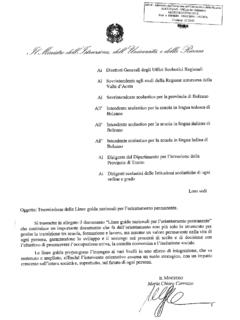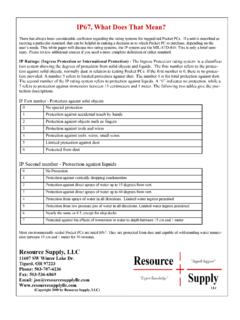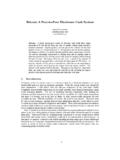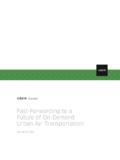Transcription of Active Low-Pass Filter Design (Rev. B) - TI.com
1 Application ReportSLOA049B - September 20021 Active Low-Pass Filter DesignJim KarkiAAP Precision AnalogABSTRACTThis report focuses on Active Low-Pass Filter Design using operational amplifiers. Low-passfilters are commonly used to implement antialias filters in data-acquisition systems. Designof second-order filters is the main topic of tables are developed to simplify circuit Design based on the idea of cascading lower-order stages to realize higher-order filters. The tables contain scaling factors for the cornerfrequency and the required Q of each of the stages for the particular Filter being enables the designer to go straight to the calculations of the circuit-component illustrate an actual circuit implementation, six circuits, separated into three types of filters(Bessel, Butterworth, and Chebyshev) and two Filter configurations (Sallen-Key and MFB),are built using a TLV2772 operational amplifier.
2 Lab test data presented shows theirperformance. Limiting factors in the high-frequency performance of the filters are .. 2 Filter Characteristics3.. 3 Second-Order Low-Pass Filter Standard Form3.. 4 Math Review4.. 5 Examples4.. Second-Order Low-Pass Butterworth Filter5.. Second-Order Low-Pass Bessel Filter5.. Second-Order Low-Pass Chebyshev Filter With 3-dB Ripple5.. 6 Low-Pass Sallen-Key Architecture6.. 7 Low-Pass Multiple-Feedback (MFB) Architecture7.. 8 Cascading Filter Stages8.. 9 Filter Tables8.. 10 Example Circuit Test Results11.. 11 Nonideal Circuit Operation14.. Nonideal Circuit Operation Sallen-Key14.. Nonideal Circuit Operation MFB16.. 12 Comments About Component Selection17.. 13 Conclusion17.. Appendix A Filter - Design Specifications19.. SLOA049B2 Active Low-Pass Filter DesignAppendix B Higher-Order Filters21.. List of Figures1 Low-Pass Sallen-Key Architecture6.
3 2 Low-Pass MFB Architecture7.. 3 Building Even-Order Filters by Cascading Second-Order Stages8.. 4 Building Odd-Order Filters by Cascading Second-Order Stages and Adding a Single Real Pole8.. 5 Sallen-Key Circuit and Component Values fc = 1 kHz11.. 6 MFB Circuit and Component Values fc = 1 kHz11.. 7 Second-Order Butterworth Filter Frequency Response12.. 8 Second-Order Bessel Filter Frequency Response12.. 9 Second-Order 3-dB Chebyshev Filter Frequency Response13.. 10 Second-Order Butterworth, Bessel, and 3-dB Chebyshev Filter Frequency Response13.. 11 Transient Response of the Three Filters14.. 12 Second-Order Low-Pass Sallen-Key High-Frequency Model14.. 13 Sallen-Key Butterworth Filter With RC Added in Series With the Output15.. 14 Second-Order Low-Pass MFB High-Frequency Model16.. 15 MFB Butterworth Filter With RC Added in Series With the Output16.. B 1 Fifth-Order Low-Pass Filter Topology Cascading Two Sallen-Key Stages and an RC22.
4 B 2 Sixth-Order Low-Pass Filter Topology Cascading Three MFB Stages23.. List of Tables1 Butterworth Filter Table9.. 2 Bessel Filter Table9.. 3 1-dB Chebyshev Filter Table10.. 4 3-dB Chebyshev Filter Table10.. 5 Summary of Filter Type Trade-Offs18.. 6 Summary of Architecture Trade-Offs18.. 1 IntroductionThere are many books that provide information on popular Filter types like the Butterworth,Bessel, and Chebyshev filters, just to name a few. This paper will examine how to implementthese three types of will examine the mathematics used to transform standard Filter -table data into the transferfunctions required to build Filter circuits. Using the same method, Filter tables are developed thatenable the designer to go straight to the calculation of the required circuit-component Filter implementation is shown for two circuit topologies: the Sallen-Key and the MultipleFeedback (MFB). The Sallen-Key circuit is sometimes referred to as a voltage-controlled voltagesource, or VCVS, from a popular type of analysis is common practice to refer to a circuit as a Butterworth Filter or a Bessel Filter because itstransfer function has the same coefficients as the Butterworth or the Bessel polynomial.
5 It is alsocommon practice to refer to the MFB or Sallen-Key circuits as filters. The difference is that theButterworth Filter defines a transfer function that can be realized by many different circuittopologies (both Active and passive), while the MFB or Sallen-Key circuit defines an architectureor a circuit topology that can be used to realize various second-order transfer Active Low-Pass Filter DesignThe choice of circuit topology depends on performance requirements. The MFB is generallypreferred because it has better sensitivity to component variations and better high-frequencybehavior. The unity-gain Sallen-Key inherently has the best gain accuracy because its gain isnot dependent on component CharacteristicsIf an ideal Low-Pass Filter existed, it would completely eliminate signals above the cutofffrequency, and perfectly pass signals below the cutoff frequency. In real filters, various trade-offsare made to get optimum performance for a given filters are termed maximally-flat-magnitude-response filters, optimized for gainflatness in the pass -band.
6 The attenuation is 3 dB at the cutoff frequency. Above the cutofffrequency the attenuation is 20 dB/decade/order. The transient response of a Butterworth filterto a pulse input shows moderate overshoot and filters are optimized for maximally-flat time delay (or constant-group delay). This meansthat they have linear phase response and excellent transient response to a pulse input. Thiscomes at the expense of flatness in the pass -band and rate of rolloff. The cutoff frequency isdefined as the 3-dB filters are designed to have ripple in the pass -band, but steeper rolloff after thecutoff frequency. Cutoff frequency is defined as the frequency at which the response falls belowthe ripple band. For a given Filter order, a steeper cutoff can be achieved by allowing morepass-band ripple. The transient response of a Chebyshev Filter to a pulse input shows moreovershoot and ringing than a Butterworth Low-Pass Filter Standard FormThe transfer function HLP of a second-order Low-Pass Filter can be express as a function offrequency (f) as shown in Equation 1.
7 We shall use this as our standard (f)+*K fFSF fc 2)1 QjfFSF fc)1 Equation 1. Second-Order Low-Pass Filter Standard FormIn this equation, f is the frequency variable, fc is the cutoff frequency, FSF is the frequencyscaling factor, and Q is the quality factor. Equation 1 has three regions of operation: belowcutoff, in the area of cutoff, and above cutoff. For each area Equation 1 reduces to: f<<fc HLP(f) K the circuit passes signals multiplied by the gain factor K. ffc+FSF HLP(f)+*jKQ signals are phase-shifted 90 and modified by the Q factor. f>>fc HLP(f) K FSF fcf 2 signals are phase-shifted 180 and attenuated by thesquare of the frequency attenuation at frequencies above fc increasing by a power of 2, the last formula describes asecond-order Low-Pass Low-Pass Filter DesignThe frequency scaling factor (FSF) is used to scale the cutoff frequency of the Filter so that itfollows the definitions given ReviewA second-order polynomial using the variable s can be given in two equivalent forms: thecoefficient form: s2 + a1s + a0, or the factored form; (s + z1)(s + z2) that is: P(s) = s2 + a1s + a0 = (s + z1)(s + z2).
8 Where z1 and z2 are the locations in the s plane wherethe polynomial is three filters being discussed here are all pole filters, meaning that their transfer functionscontain all poles. The polynomial, which characterizes the Filter s response, is used as thedenominator of the Filter s transfer function. The polynomial s zeroes are thus the Filter s even-order Butterworth, Bessel, or Chebyshev polynomials contain complex-zero pairs. Thismeans that z1 = Re + Im and z2 = Re Im, where Re is the real part and Im is the imaginarypart. A typical mathematical notation is to use z1 to indicate the conjugate zero with the positiveimaginary part and z1* to indicate the conjugate zero with the negative imaginary part. Odd-order filters have a real pole in addition to the complex-conjugate Filter books provide tables of the zeros of the polynomial which describes the Filter , othersprovide the coefficients, and some provide both.
9 Since the zeroes of the polynomial are thepoles of the Filter , some books use the term poles. Zeroes (or poles) are used with the factoredform of the polynomial, and coefficients go with the coefficient form. No matter how theinformation is given, conversion between the two is a routine mathematical the transfer function of a Filter in factored form makes it easy to quickly see thelocation of the poles. On the other hand, a second-order polynomial in coefficient form makes iteasier to correlate the transfer function with circuit components. We will see this later whenexamining the Filter -circuit topologies. Therefore, an engineer will typically want to use thefactored form, but needs to scale and normalize the polynomial at the coefficient form of the second-order equation, it is seen that when s << a0, theequation is dominated by a0; when s >> a0, s dominates. You might think of a0 as being thebreak point where the equation transitions between dominant terms.
10 To normalize and scale toother values, we divide each term by a0 and divide the s terms by c. The result is:P(s)+ sa0 wc 2)a1sa0 wc)1. This scales and normalizes the polynomial so that thebreak point is at s = a0 making the substitutions s = j2 f, c = 2 fc, a1+1Q, and a0 = FSF, the equation becomes:P(f)+ fFSF fc 2)1 QjfFSF fc)1, which is the denominator of Equation 1 our standardform for Low-Pass the rest of this article, the substitution: s = j2 f will be routinely used following examples illustrate how to take standard Filter -table information and process it intoour standard Active Low-Pass Filter Low-Pass Butterworth FilterThe Butterworth polynomial requires the least amount of work because the frequency-scalingfactor is always equal to a Filter -table listing for Butterworth, we can find the zeroes of the second-order Butterworthpolynomial: z1 = + , z1* = , which are used with the factored form ofthe polynomial.














